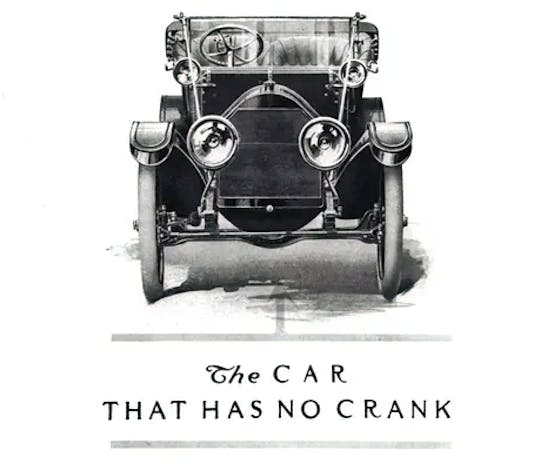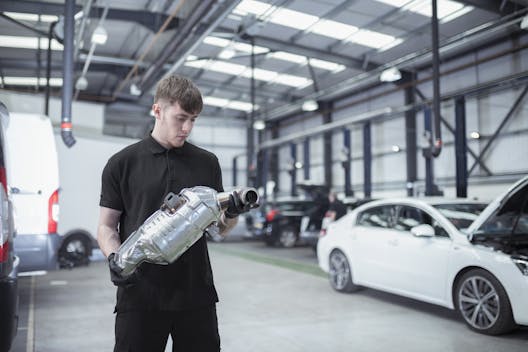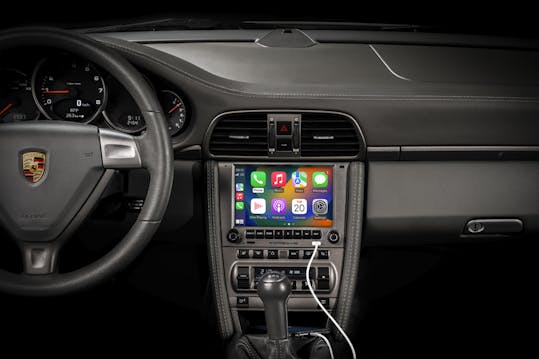Our Two Cents: What was the most important automotive invention?
Time always marches forward, sometimes upward when it comes to technology. In the world of the automobile, that march of progress has been a good thing. Cars get better and better over time, but a singular innovation usually sparks the change that sends the trajectory climbing even higher. I asked my cohorts at Hagerty Media for the automotive invention they think has made the biggest difference. I even started off with some low hanging fruit to get their wheels turning:
- Tubeless tire
- Oil Filter
- Cup Holder
- Cigarette lighter
So let’s see what the gang came up with for this installment of Our Two Cents. I expect you’ll be surprised by a few of them.
The hand crank delete?

“Charles Kettering’s self-starter for the 1912 Cadillac.” –Joe DeMatio
“Another step forward that borders on being as important as Joe’s with the electric starter would be synchronized gears. Don’t get me wrong, one of the best feelings in the world is double clutching an unsynchronized box and getting the shift perfect, but the convenience of not having to double clutch cannot be understated.” –Greg Ingold
Three-point safety belts

“I am gonna go with Volvo’s three-point seatbelt, created by engineer Nils Bohlin.” –Eric Weiner
“Airbags owe their implementation to a whole lot of inventors. Cars would be a lot less safe without them.” –Brandan Gillogly
You can’t pick just one!

“I have a few that stick out in my mind: implementing the assembly line for automobiles, electronic fuel injection, the catalytic converter, and definitely radial tires.” –Larry Webster
“Safety glass and disc brakes.”–Todd Kraemer
Standardized Controls

“I’m going to go with the traditional control layout. Accelerator on the floor to the right, brake pedal on the center and clutch on the left. Drive something like a Model T where it is a combination of hand and foot controls and you’ll quickly appreciate the standardization.” –Greg Ingold
“To Greg’s point, even the steering wheel.” –Todd Kraemer
Not standardized controls?

“Haptic volume and HVAC sliders, for the purpose of reminding everyone that physical controls are and always will be superior.” –Eddy Eckart
“And to combine Eddy and Todd’s comments above, let’s mention Tesla’s yoke steering wheel.” –Sajeev Mehta
The love of the rings?

“The piston ring. The ability to seal a cylinder and moving piston, especially in a way that has any longevity in the environment created by combustion, is amazing and the reliability and longevity of the piston ring is likely what has allowed the automobile to progress from a novelty to near necessity. Imagine if engines required re-ringing after just 20k miles: Would we use cars and trucks the way we do today? It’s one of the hardest working parts of an engine and rarely is ever thought of until failure.” –Kyle Smith
“I’m kinda glad for the failures present in piston ring design, otherwise I wouldn’t have a silly name for my advice column.” –Sajeev “Piston Slap” Mehta
Overhead valve engines?

“Pushrods. Heck yeah!” –Cameron Neveu
Integrated circuitry

“While I admit that electronics are reaching too far in some instances, our motoring lives have improved significantly once the integrated circuit made its way into the automobile. There’s solid state ignition, improved radio performance, anti-lock brakes, the gauge cluster on the Series I Aston Martin Lagonda … the list goes on and on.” –Sajeev Mehta
Smartphone integration

“Apple CarPlay, and I am approximately 64% serious about that.” –Grace Houghton
“General Motors would like a word about that, Grace.” –Nathan Petroelje
One for Minivan
“Automatic sliding doors on minivans.” –Ben Woodworth
***
Check out the Hagerty Media homepage so you don’t miss a single story, or better yet, bookmark it. To get our best stories delivered right to your inbox, subscribe to our newsletters.



There are two inventions that have changed the history if the car.
The First one is one my Great Uncle who was a Automotive engineer in the late teens after WW1. He grew up at a time when there were no planes and he got to see man land on the moon. He saw it all and was a major part of it working for GM and GMC.
He always said the greatest thing to ever happen was the SAE standardization of fasteners. He said if that had neve happened the advancements would have taken 3 times longers to accomplish not only on cars but everything else.
Now here is my choice. The greatest invention on a car is brakes. in particular the duel master cylinder hydraulic brakes.
I have always said it does not matter about anything else on a vehicles as if you can’t stop you have nothing. You may have the fastest car in the world like Craig Breedlove but when he could not stop the Sprit of America he was hitting phone poles and launched into the salt lake.
As soon as car moved under their own power brakes became the primary need.
As I was going through the list I was wondering where is the hydraulic brake mentioned. More than anything else it revolutionized the automobile for women. And it provided greater stopping power which in turned allowed faster and more powerful engines.
A little less significant than some of the other items noted, but certainly somewhere north of cupholders, is the intermittent wiper control. Certainly well recognized in the safety category, and also a convenience. Not to mention an interesting backstory on the invention and inventor.
Here, here on hydraulic and later hydraulic disc brakes!!! 🙂
Dual, unless the brakes are fighting.
Is the duel(ing) master cyl something to do with antilock brakes? Always wondered how that worked!!
Or did you mean the DUAL master cyl??? Similar to how so many people refer to the “Breaks” stopping the car. I guess when something “breakes” it does not require “brakes” to eventually bring the car to a stop – – –
Some people put the petal to the medal.
*dual
The first car I legally drove regularly on the street was a 1931 Ford with mechanical brakes. This was in the summer of 1961. Hydraulic brakes were a huge improvement.
I think there were 4 inventions that made the automobile a responsible citizen.
1. The self starter. You no longer had to be a young, strong, guy t drive, and injuries and deaths due to crank starting cars were eliminated.
2. The Hydra-matic transmission. You no longer had to massage the car’s drivetrain to drive, and handicapped people, with one arm or one leg, could now drive.
3. Airbags. Passive restraints, based on GM’s 1973 air bags, have saved millions of lives, worldwide.
4. Catalytic convertor. Catalytic convertors are the basis of modern emission systems that have cleaned the air, and extended the lives of millions.
Everything else are just refinements.
Really, MILLIONS of lives saved by airbags? Seatbelts and better crash worthy structures probably, but not airbags alone.
Seatbelts are indeed effective and have been offered since the 50’s and standard since the mid-60’s but usage was not guaranteed (“They’re uncomfortable to sit on!” or “They’re takin’ away mah free-dumb!”). After lackluster success with buzzers, interlocks and mechanical automatic belts, a true passive restraint system was needed. Airbags have demonstrated themselves to be a lifesaver (injuries are be another story).
Seats
Cast aluminum valve covers. Look at any picture of a parking lot from the 70s and it’s pretty clear why
😁
I love this one! (Former Chief Engineer at Fel-Pro gaskets)
JFC….tubeless tires.
The wheel. That’s where it all starts!
The wheel is a toy. The axle is the enabling technological breakthrough.
I’ve said that for years and usually get a blank stare
Well for me, the most important was the paycheck, because until I started getting one, everything else “automotive” was just dreamin’!
chrome!
The V8, turbocharging, anti-lock brakes, AWD. So many things to think about.
Sports bra’s and yoga pants. Car pictures have never really been the same since.
Linda Vaughn
And Jungle Pam!
Next to nitromethane jungle Jim & Pam was one of the best things that ever happened to drag racing! Great pit crew…
Mean Mary Jean
Tires
If you live in colder climates, you can really appreciate fuel injection replacing carburetors. Also overhead cam engines. Of course all the advances in braking and safety are key as well.
Fuel injection and electronic ignition were big improvements for those of us who live up north and suffered with hard starting and slow warm up every winter. Nothing worse than trying to coax the engine to turn over with a freezing can of Gumout starting spray at -10 degrees with a brisk wind blowing!
Synthetic oil allowing that engine to turn over at -20 in northern Maine
Absolutely. Fuel Injection and Electronic Ignition were key to the unbelievable reliability of automobiles that most of us have taken for granted. There have been so many great advancements over the last 100 years, but the reliability and longevity of today’s automobiles has to be near the top.
Fuel injection , electronic ignition, and variable valve timing, combined with LEAD FREE GAS have extended the life of engines and reduced the required maintenance more than anything since the introduction of LEADED GAS. Leaded gas allowed higher compression ratios to produce more power and better fuel economy, and electronic fuel injection and ignition along with variable valve timing allowed accurate enough control over the combustion process to allow engines to run higher compression ratios and provide more power and better fuel economy WITHOUT the lead. Just think of those 6.4 liter 4 cyl engines pumping out a massive 60 HP like the Wisconsin that powered the Stutz Bear-cat back in 1912/13.
Fuel injection it is. As a recently minted, inexperienced teen driver, my Dad had bought a new 454 4bbl Caprice in ‘75. Never experienced a car that was as temperamental to cold start when the temps dropped below zero as that one. If it didn’t fire off in the first attempt, it usually flooded and with a sub zero weakened battery, wasn’t long before you had had to make the dreaded phone call home.
I think the big reason FI works so well is because of the feedback from the sensors so the computer can optimize fuel/air ratio, timing, and idle speed. I’ve never driven a pre-sensor FI car (e.g. Corvette fuelie) but I suspect its the electronic control/sensor that makes it work much better than a carb.
I completely agree with you! I was going to state the same thing. Kudos!
To really expand on this, visit the Automotive Hall of Fame in Detroit (Dearborn) on the campus of the Henry Ford Museum…. it documents the inventions and their inventors who shaped the development of the automobile through the years… some you never heard of …. well worth a trip…
The “Weather Eye“ was introduced in 1939, a trade name for a Nash Motors designed fresh-air system for automobile passenger compartment heating, cooling, and ventilating. The Nash “All-Weather Eye” was the first automobile air conditioning system for the mass market. In 1954, Nash introduced the first modern, fully integrated automotive air-conditioning system. Already an industry leader in heaters and ventilation with its Weather Eye system, the company called its integrated air-conditioning system All-Weather Eye. Here, all the hardware that formerly filled up a good part of the trunk was now neatly tucked into the cowl and hidden behind the dash
The use of the Weather Eye name for automobile passenger heating and air conditioning systems continued in American Motors Corporation (AMC) vehicles. The design principles of the Nash Weather Eye system are now in use by nearly every motor vehicle.
I would second that. Try finding a modern car without a/c.
I have to go with the self starter. Ms magazine felt it was so important in liberating women to drive without the presence of a man, that they named Charles Kettering to their list of the 100 greatest feminists of all time. And along the way, it saved men countless injuries from having to turn a crank starter.